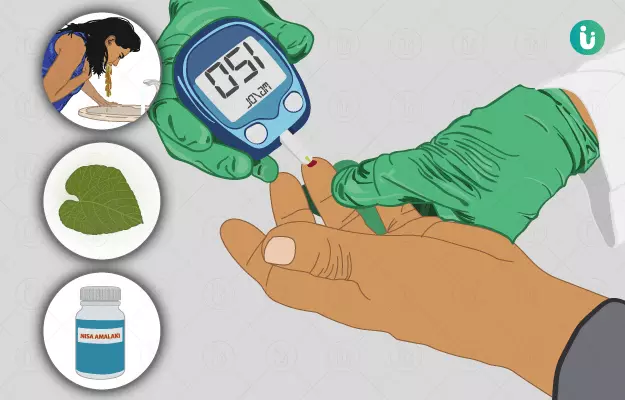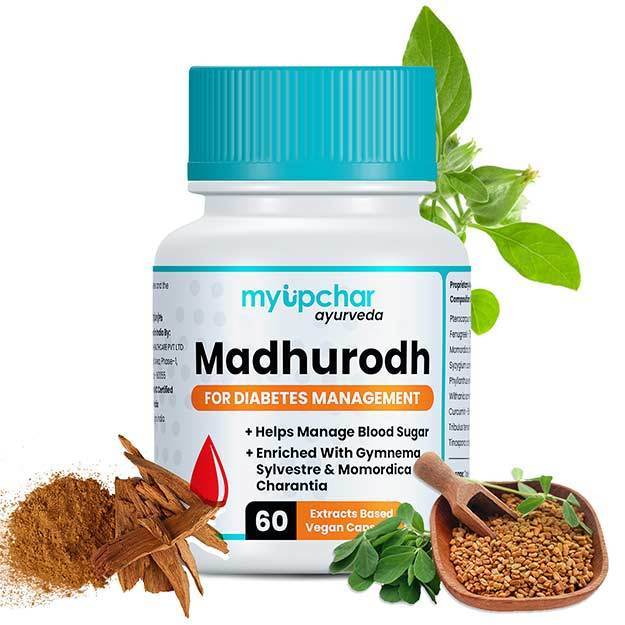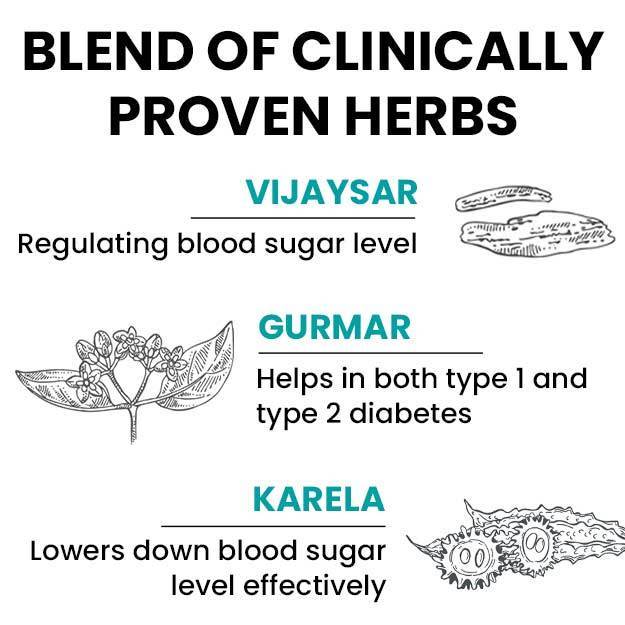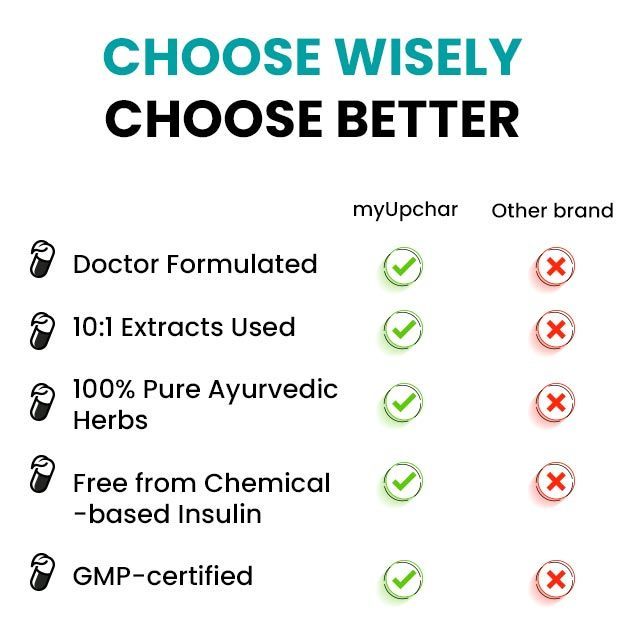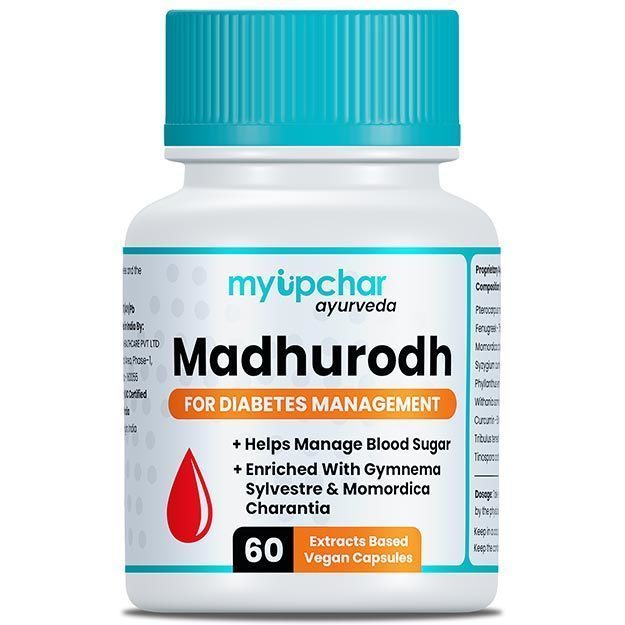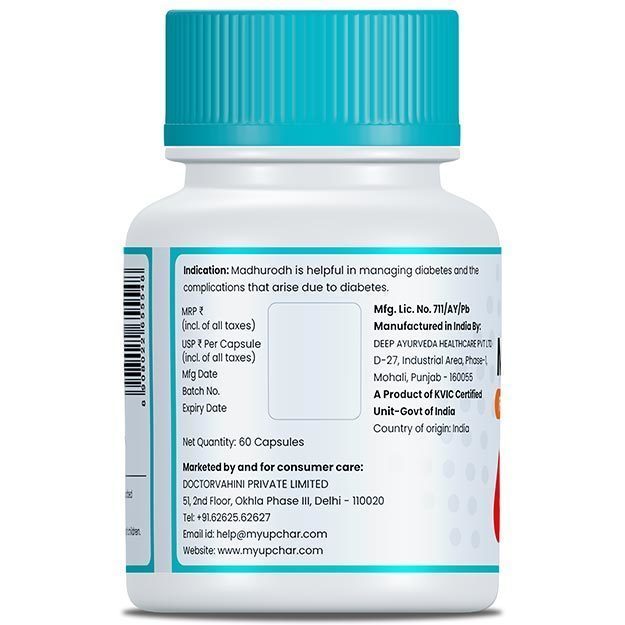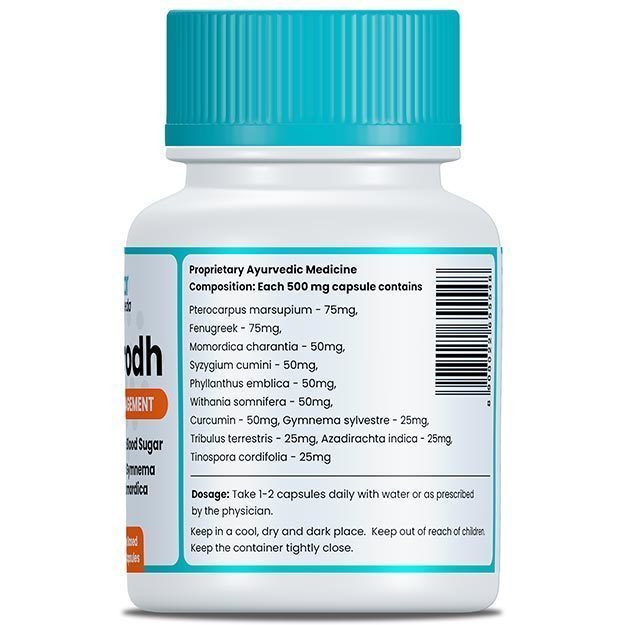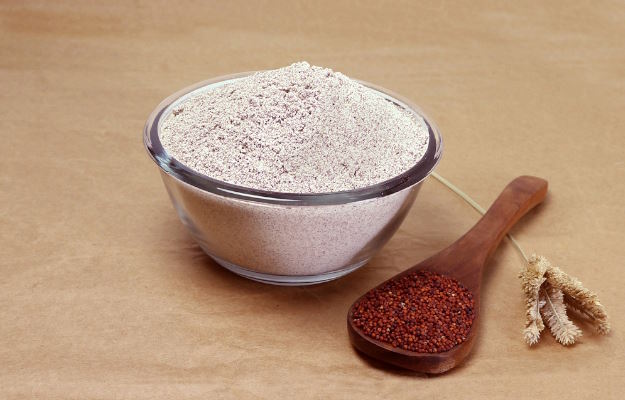Diabetes, known as madhumeha in Ayurveda, is one of the fastest growing diseases across the world and is mainly characterised by an increased level of glucose in blood. The first incidence of this disease can be dated back to 1000 BC. Back then, Charaka Samhita and Sushruta Samhita defined diabetes as a condition with frequent urination, wherein, urine of the affected person was found to be astringent and sweet.
Ayurveda states that diabetes mellitus can be caused due to multiple factors. It primarily occurs due to improper metabolic functioning of the body and leads to dysfunction or deficiency of the hormone insulin. The primary factors that increase the risk of diabetes include diet, lifestyle, environment and all the other factors that may lead to aggravation of kapha dosha.
Here is the complete detail about the ayurvedic treatment of diabetes.
Hereditary and genetic factors are also commonly known causes of diabetes. Avoiding the causative factors of diabetes, making lifestyle changes such as exercising regularly and performing yoga, diet management, and taking appropriate medicines is prescribed by Ayurvedic doctors for the treatment of diabetes.
Ayurvedic physicians suggests treatments like udwartana (powder massage), dhanyamla dhara (pouring warm medicated liquid), sarvang abhyanga (full body oil massage), swedana (sudation or sweat therapy), sarvang ksheeradhara (oil bath), vamana karma (medical emesis) and virechana karma (purgation therapy) for the treatment of diabetes mellitus. Herbs like karavellaka (bitter gourd), amalaki (Indian gooseberry), meshashringi (gudmar), methi (fenugreek), guduchi (giloy) and medicines like phalatrikadi kwatha, katakakhadiradi kashaya, nisha katakadi kashaya, nisha-amalaki are used in ayurvedic medicine for managing diabetes mellitus.
(Read More - Diabetic Dyslipidemia treatment)
- Ayurvedic view of diabetes
- Ayurvedic remedies for diabetes
- Ayurvedic herbs for diabetes
- Dietary and lifestyle changes for diabetes as per ayurveda
- How effective are ayurvedic remedies for diabetes
- Side effects and risks of ayurvedic remedies for diabetes
- Takeaway
Ayurvedic view of diabetes
As per Ayurveda, prakriti (a person’s constitution) comprises their morphological, psychological, and physiological traits. The prakriti of an individual is manifested at the foetal stage and stays constant throughout life. An individual can have a dominant level of a particular dosha, e.g., vata, pitta, or kapha, which then decides his prakriti.
Diabetes is a condition in which the metabolism of an individual is disturbed, both at the gut level and tissue level. Rise in the level of kapha dosha and meda dhatu leads to diabetes. This disorder is predominantly found in individuals with kapha-dominant prakriti as compared to vata- and pitta-dominant prakriti.
Diabetes can be classified as vata prameha, pitta prameha and kapha prameha depending on the involvement of the dosha responsible for it. Kapha prameha is curable, pitta prameha is manageable, while vata prameha is incurable. It is indicated that individuals with a prakriti that is highly prone to diabetes should adopt various lifestyle and dietary management techniques to prevent this disease.
(Read More - Diabetic Gastroparesis treatment)
Ayurvedic remedies for diabetes
The Ayurvedic treatment of diabetes is as follows
- Udwartana
- It is a unique therapeutic powder massage that is performed using a combination of herbs that balances all doshas of an individual.
- The powder is warmed before the treatment, and strokes in an upward direction are given to the area under treatment while massaging deeply.
- This is a 45- to 60-minute procedure, following which, the individual may take rest for about 30 minutes and then take a shower.
- It treats diabetes by reducing the kapha dosha and the excess accumulated fats in the body.
- Dhanyamla dhara
- Dhara is the process of pouring warm medicated liquid on a part of the body or over the entire body. Dhara is of two types – parisheka (pouring of warm medicated liquid or oil on a particular part of the body) and avagahan (sitting inside a tub filled with a medicated decoction).
- In dhanyamla dhara, a lukewarm medicated liquid made from dhanya (cereals) and amla (vinegar) is used to balance kapha and vata disorders.
- Sarvang abhyanga and swedana
- Sarvang abhyanga is the process of pouring oil all over the body and massaging. It stimulates the lymphatic systems, which are known to play a role in nutrient supply to the cells and removal of toxins from body.
- After the oil massage is completed, sweat therapy is employed to enable efficient dislodging and dissolving of ama (toxins) in the body.
- Swedana widens all channels of body, enhances the movement of the toxins from blood into the gastrointestinal tract from where they are quickly eliminated.
- There are four different forms of swedana —tapa (fomentation), in which a heated cloth is placed on the body part, upanaha, in which a hot poultice made from a combination of medicated herb is applied to the body, ushma, in which warm steam made by boiling herbs suitable for a particular dosha is used, and dhara, in which a medicated warm liquid or oil is poured over the body.
- Sarvang ksheeradhara
- Shirodhara is an Ayurvedic treatment in which various liquids such as milk or oils mixed with a decoction of herbs are rhythmically poured over the head.
- Sarvanga ksheeradhara, also known as an oil bath, is the application of a suitable oil on the head and the whole body.
- Vamana karma
- It is one of the panchakarma (five procedures) therapies which cleanses the stomach and removes ama and mucus from naadis (channels) and chest by inducing vomiting.
- It is performed by making the individual consume salt water, kutaj (kurchi), or liquorice, and vacha (calamus). The effects of vamana therapy can be further potentiated by using certain herbs like pippali (long pepper), rock salt, amalaki (amla), neem and madana phal (emetic nut).
- It is mainly used for the treatment of kapha diseases.
- This karma is not recommended in children, pregnant women and the elderly. It is also avoided in individuals with disorders like high blood pressure, vomiting, heart problems, gastrointestinal disorders, constipation, cataract, enlarged spleen or abdomen and weakness.
- Post vamana, hands, face, and feet should be washed, and inhalation of herbal smoke should be performed. Appropriate sleep or rest is essential. After waking up from sleep, hands, face, and feet are washed again.
- Virechana karma
- Virechana is one of the main panchakarma therapies and has excellent observable effects.
- Various purgatives like senna, rhubarb, or aloe are given to the individual so as to remove and cleanse toxins from the body.
- Virechana is also used to treat many conditions like abdominal tumour, piles, and ulcer, gout, etc., along with diabetes.
- It is not advised in individuals with recent fever, poor digestion, rectum ulcers, and diarrhoea. Virechana is not recommended for children, elderly, weak, pregnant and debilitated individuals.
Rice and lentil soup should be consumed after completion of virechana procedure.
(Read More - Homeopathic treatment for Diabetes)
Ayurvedic herbs for diabetes
Ayurvedic Herbs for Diabetes
- Amalaki
- This herb is a rejuvenator and pacifies all three doshas.
- It is useful in the treatment of many diseases such as diabetes in a wide range of population, e.g., children, adults, and elderly. Necessary precautionary measures should be taken in pregnant women.
- A potential side effect of amalaki is acute diarrhoea in individuals with pitta dosha.
- Meshashringi or gudmar
- Gudmar means sugar destroying. The roots and leaves of this herb are used in the treatment of diabetes mellitus. Research shows that it removes sweetness from bittersweet mixtures and reduces sweet cravings. Gudmar also restores pancreatic function.
- Gudmar is one of the main herbs used in the treatment of diabetes mellitus. Leaves of this herb stimulate the heart; therefore, caution should be taken while giving this herb to individuals with heart disease.
- Karavellaka
- This herb is an excellent treatment for diabetes as it cleanses blood. It is also known for its other properties like high vitamin C content, weight reduction potential, etc.
- The suitability of this herb in the treatment of diabetes varies from individual to individual, and it should only be taken under the directions of a physician.
- Guduchi
- Roots and stem of giloy are used in treating disorders of the circulatory and digestive system.
- It is appropriate for the treatment of diabetes mellitus as it acts as a bitter tonic and has sugar-lowering activity.
- Methi
- Methi has been used since ancient times as a rejuvenator and stimulant and is known to cure diabetes.
- This herb is prescribed to individuals based on their clinical condition. It should not be used in pregnant women.
Ayurvedic Medicines for Diabetes
- Phalatrikadi kwatha
- It is a decoction that consists of equal amounts of fruits of amalaki, haritaki (chebulic myrobalan), and vibhitaki (belleric myrobalan) along with the stem of daruharidra (Indian beriberi), indrayan (colocynth) root and mustaka (nutgrass).
- It is used in treating all types of diabetes by improving the digestion of food and proper absorption of its breakdown products. This medicine also improves the removal of undigested food as well as the undigested metabolites from the body.
- Katakakhadiradi kashaya
- Katakakhadiradi kashaya is a herbal decoction made using an equal amount of herbs such as kataka (clearing nut tree), khadira (black catechu), amalaki, daruharidra, haridra (turmeric), abhaya, and chootabija (mango seed), etc.
- This kashaya is shown to have antioxidant properties. It controls both vata and pitta-related diseases and is useful in treating diabetes and diabetic neuropathy.
- Nisha katakadi kashaya
- It consists of the following 12 herbs – kataka, khadira, amalaki, vairi (kothala himbutu), daruharidra, samanga (little tree plant), vidula (freshwater mangrove), haridra, patha (velvet leaf), chootabija (mango seeds), haritaki and mustaka.
- This kashaya relieves symptoms of diabetes such as fatigue, burning sensation in the hands and feet, excessive thirst, and excessive urination. Overall, it improves the quality of life and is efficient in the management of diabetes mellitus. It can be used alone as well as in combination with yasada bhasma (zinc oxide powder).
- Nisha-amalaki
- This is a combination of turmeric and Indian gooseberry recommended in Ayurvedic classics for the treatment of diabetes. It is prepared by mixing turmeric powder with the juice of amalaki in the ratio of 1:0.5.
The various complications of diabetes like diabetic neuropathy, nephropathy, retinopathy, gastropathy, and atherosclerosis can be prevented and managed using this combination.
(Read More - Diabetes Insipidus treatment)
Dietary and lifestyle changes for diabetes as per ayurveda
Do’s
- Include cereals like barley, certain varieties of rice (samvaka and kodrava), and wheat in your diet.
- Include pulses like green gram, kulattha (horsegram), pigeon pea, alsi, and chickpea in your diet.
- Include fruits and vegetables like patola, bitter gourd, amalaki, haridra, kapittha (wood apple), and black pepper in diet.
- Honey and rock salt can also help in managing diabetes mellitus.
- Physical activities like walking, playing, and regular exercise should be incorporated in your daily routine.
Don’ts
- Do not eat black gram or freshly harvested/new rice and grains.
- Avoid food items like milk, curd, buttermilk, oil, jaggery, alcohol, sugarcane products, clarified butter, and betel.
- Do not munch on foods or snack unnecessarily.
- Do not eat incompatible foods together such as fish and milk/milk products.
- Avoid sleeping during the day.
- Avoid smoking.
(Read More - Diabetic Ketoacidosis treatment)
How effective are ayurvedic remedies for diabetes
Many studies have been performed to identify and study various Ayurvedic treatments for diabetes, and all the reviews give positive results regarding these medicines and treatments.
- A study conducted to determine the efficiency of phalatrikadi kwatha in the treatment of diabetes indicated that both fasting and postprandial sugar levels reduced to a significant level within eight weeks of treatment. It was found to be a safe and effective treatment in both old and new cases of diabetes.
- A review study indicated that many clinical trials have been conducted to check the effects of nisha amalaki on blood glucose levels. Most of them report that this formulation lowers blood sugar levels effectively and can be used in managing and preventing diabetes-related complications.
(Read More - Exercises for Diabetes)
Shilajit capsules and Shilajit Resin, from myUpchar Ayurveda, offers natural support for diabetes management. Its unique properties help regulate blood sugar levels, promoting overall well-being. Order now for holistic diabetes care
Side effects and risks of ayurvedic remedies for diabetes
Amalaki, karavellaka, guduchi, and methi are useful in the treatment of diabetes; however, amalaki should be given with caution and methi should be avoided in pregnant women. All the medicines described in the treatment also have amalaki as one of their ingredients. Although these medicines are effective in treating diabetes, they should be used only after consulting a doctor.
(Read More - Diabetes diet)
Takeaway
Diabetes is a metabolic disease that needs effective treatment and lifestyle modifications for proper management and avoiding complications. Ayurveda focuses on managing all the factors that cause diabetes along with preventing diabetes complications. Ayurvedic treatment of diabetes involves simple and effective changes to incorporate in our routine and herbal remedies to prevent and alleviate diabetes symptoms.
(Read More - Gestational Diabetes Diet)
Find Ayurvedic Doctor in cities
Doctors for Ayurvedic Rremedies for Diabetes

Dr. Megha Sugandh
Ayurveda
6 Years of Experience

Dr. Nadeem
Ayurveda
3 Years of Experience

Dr.Ashok Pipaliya
Ayurveda
12 Years of Experience

Dr. Harshaprabha Katole
Ayurveda
7 Years of Experience
References
- P Srinivas, K Prameela Devi, B Shailaja. Diabetes Mellitus (Madhumeha)-An Ayurvedic Review. International Journal of Pharmacy and Pharmaceutical Sciences, Vol 6, Suppl 1, 2014.
- N.Srikanth. Diabetes Mellitus (Madhumeha) and Ayurvedic management : An evidence based approach . World Journal of Pharmacy and Pharmaceutical Sciences, Vol 4, Issue 08, 2015.
- Ministry of AYUSH, Govt. of India. Ayurvedic Standard Treatment Guidelines. [Internet]
- Chauhan Gouri, Mahapatra Arun Kumar, Babar Kapoor Alka, Kumar Abhimanyu. Clinical Efficacy Of Phaltrikadi Kwath In Controlling Blood Sugar Level In Prameha (Type 2 Diabetes Mellitus). Ayushdhara, March-April 2015 :Vol 2 Issue 2.
- S Angelie Jessica et al. Antioxidant Study of One Ayurvedic Preparation Katakakhadiradi Kashayam. Journal of Pharmaceutical Sciences and Research; Vol. 9(9), 2017, 1427-1429.
- Pitta Srinivas. Clinical Evaluation of Nisha Katakadi Kashaya and Yashada Bhasma in the Management of Type-2 Diabetes Mellitus (Madhumeha) : A Multicentre, Open Label Prospective Study. Journal of Research in Ayurvedic Sciences, April- June 2018; 2(2): 108-121.
- Dr. Prashant Bedarkar. Review Of Nisha Amalaki –An Ayurvedic Formulation Of Turmeric And Indian Goose Berry In Diabetes. World Journal Of Pharmaceutical And Medical Research, 2017,3(9), 101-105.
- Vikaspedia. Ayurveda for common disease conditions. Ministry of Electronics and Information Technology.
- Bishnu Choudhary. Diabities Mellitus : A comparative study as per Ayurvedic and Modern Classics . International Journal of Research IN, 7(1), Jan- Feb 2016.


